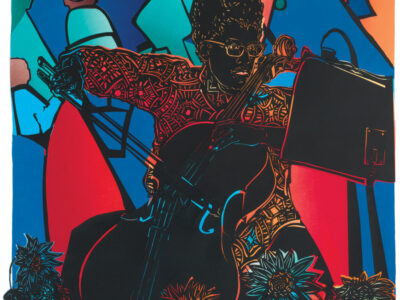
“Imagination Station, Detroit” (2008) by Andrew Moore.
The notion of a sense of place almost always includes the sense of sight. But Landscape/Soundscape, on view at the Arthur Ross Gallery through March 26, places an equal amount of weight on hearing. In doing so, the exhibit invites us to close our eyes and, well, complete the picture.
Take Andrew Moore’s archival digital print “Imagination Station, Detroit” (2008), a startling juxtaposition that captures Michigan Station, the city’s abandoned rail terminal and one of America’s most famous urban ruins, looming over two all-but-destroyed houses. Depending on who’s doing the viewing, the desolate imagery—a grey sky, a very dead tree, a crumbled sidewalk, a forlorn television left to rot in the open air—may read as eerie or sad; it could be commentary or simply documentation.
Put on the headphones installed below the photo, though, and whatever effect you’re feeling is seriously heightened—or contradicted. There’s static, there’s buzzing, there’s rumbling. It’s the ghost of a train; it’s a saw completing the demolition of the homes; it’s that darned TV, on the fritz. It’s foreboding as hell, discordant and not at all pretty.
To make this abstract four-minute work, Philadelphia-based audiovisual artist and electronic musician Michael Roy Barker converted the digital image into a sound file and then manipulated the result to reflect the “layers of decay” he saw in the image. He created a sense of place, all right, but not out of any personal memories and not, necessarily, an accurate one. “I’ve never been to Detroit,” he says, “but the photo made me think of the pre-conceived notions and the misinformation we may have when it comes to the city.”
The same could be said of the entire exhibit, which by encouraging us to listen forces us to look—again and more deeply. Given her first chance to curate what’s become an annual collaboration between the gallery and the University’s Office of the Curator, Heather Gibson Moqtaderi LPS’14, art-collections manager and associate curator, says she was “drawn to landscape photography because I felt it was a strength of the collection that hadn’t yet been showcased.” But as she leafed through the images, she began “hearing things,” she says. “There seemed to be a sonic resonance, sometimes rhythmic, sometimes ambient, to many of them.”
Eventually Gibson Moqtaderi chose 10 landscapes from the University’s collection of 1,000 or so photos. To incorporate a classroom component, she also conceived of a companion exhibit featuring 11 original photos and sound compositions by 13 students pursuing degrees in everything from English to ethnomusicology to mathematics. They can be viewed in a separate kiosk at the gallery, as well as online.
For the main show, Gibson Moqtaderi asked Eugene Lew, lecturer and director of sound and music technology, to partner with her in locating sound artists who, in many cases, seemed perfect matches for their subjects. The duo paired Eliot Porter’s chromogenic print “Clouds Forming Over Mount Baker, Washington, July 30, 1975,” for example, with Los Angeles-based composer and performer Kaitlyn Aurelia Smith, who grew up on Orcas Island overlooking the mountain.
“My first reaction to the photo was to compose something ominous but I realized that is not the Mt. Baker I know,” Smith says in her artist’s statement. “I wanted to compose something that would allow the viewer to luxuriate in that feeling of achievability and wanderlust before practicality seeps in.” Her lilting piece is the most musical one here; warm and enveloping, it’s a shimmering reflection of the phosphorescence that washes the snowy tops and rushing river of Porter’s image.
Similarly, Philadelphia-based producer and sound designer Christopher Sean Powell drew upon reminiscences of his frequent trips to Nova Scotia when responding to Minor White’s gelatin silver print “Navigation Markers, Cape Breton, Nova Scotia” (1970). Gurgling with rhythmic energy, a kind of alien undercurrent offsets the jauntiness of this composition, perhaps a nod to the ET-like appearance of the objects in the photo.
Water features in even the most urban—and cacophonous—of the soundscapes, the one Lew himself fashioned to accompany “Under and Over Brooklyn Bridge and FDR Highway and Bridge,” a diptych from Karen Riedener’s silver gelatin Time Pattern (1982) series. Lew didn’t plan on including his own work in the exhibit, but when he saw Riedener’s photo collages, he changed his mind.
“I grew up playing along the East River,” he says. Tracing his finger along the meandering path of Riedener’s vertical image, Lew continues: “I fished with my grandfather not far from here.” His “St. James Place 10/30/2016” contains no added or manipulated sound, just a condensed patchwork of all that he heard on a three-hour “sound walk”: police sirens blaring, seagulls screeching, and passersby chattering in Chinese, in Spanish, in New Yorkese. As he strolled, Lew’s thoughts turned to absence. He missed everything: from the sounds he grew up with—such as the in-your-face boom-boxes of the ’80s—to his late grandmother. “They all figured into the approach I took with my piece,” he says.
—JoAnn Greco




